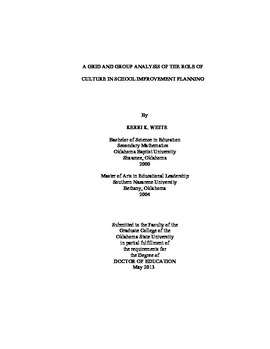| dc.contributor.advisor | Harris, Edward | |
| dc.contributor.author | White, Kerri K. | |
| dc.date.accessioned | 2014-09-24T14:16:46Z | |
| dc.date.available | 2014-09-24T14:16:46Z | |
| dc.date.issued | 2013-05 | |
| dc.identifier.uri | https://hdl.handle.net/11244/10994 | |
| dc.description.abstract | This study used purposeful sampling to select two Oklahoma public schools for qualitative case studies. The two schools had previously been identified as Schools in Need of Improvement and had shown progress since identification. Data were collected over the course of one academic year, using interviews, observations, surveys, artifacts, and document reviews. | |
| dc.description.abstract | Using Douglas's (1982, 1986) Grid and Group Typology as a theoretical frame, the two schools were described, and their experiences with the School Improvement Planning Process were compared and contrasted in order to better understand how successful schools create and implement School Improvement Plans (SIPs). | |
| dc.description.abstract | Both schools thoroughly assessed their current realities, reviewed research-based practices that were likely to improve student achievement, implemented those strategies with fidelity, and monitored the implementation and progress of students throughout the process. | |
| dc.description.abstract | Both schools focused on teacher collaboration and stakeholder buy-in. | |
| dc.description.abstract | Both schools reported increased communication among faculty members and between schools and communities, continuous professional learning of teachers and administrators, and improved student achievement as a result of the School Improvement Planning Process. | |
| dc.description.abstract | Buchanan Elementary School�s SIP was narrowly focused on reading and math achievement, but Adams High School�s SIP was not narrowly focused. | |
| dc.description.abstract | Adams High School�s SIP was more successfully implemented after new leadership disconnected improvement strategies from outside mandates. | |
| dc.description.abstract | Both schools adapted the School Improvement Planning Process to meet the needs of teachers, counselors, administrators, students, families, and community stakeholders who contribute to the school�s culture. Many of these adaptations could be understood in terms of grid and group descriptions of the school. | |
| dc.description.abstract | Both schools having a strong group culture often explained similarities between the schools� processes. Adams High School having a strong-grid culture and Buchanan Elementary School having a weak grid culture often explained differences between the schools� processes. | |
| dc.description.abstract | There were realities outside of grid and group contexts, such as state and federal requirements, motivation, demographics, and the larger contexts in which each school operated, that impacted attitudes and actions taken toward the SIP. | |
| dc.format | application/pdf | |
| dc.language | en_US | |
| dc.rights | Copyright is held by the author who has granted the Oklahoma State University Library the non-exclusive right to share this material in its institutional repository. Contact Digital Library Services at lib-dls@okstate.edu or 405-744-9161 for the permission policy on the use, reproduction or distribution of this material. | |
| dc.title | Grid and group analysis of the role of culture in school improvement planning | |
| dc.contributor.committeeMember | Kearney, Kerri | |
| dc.contributor.committeeMember | Stansberry, Susan | |
| dc.contributor.committeeMember | Utley, Juliana | |
| osu.filename | White_okstate_0664D_12605.pdf | |
| osu.accesstype | Open Access | |
| dc.type.genre | Dissertation | |
| dc.type.material | Text | |
| thesis.degree.discipline | Educational Leadership Studies | |
| thesis.degree.grantor | Oklahoma State University | |
